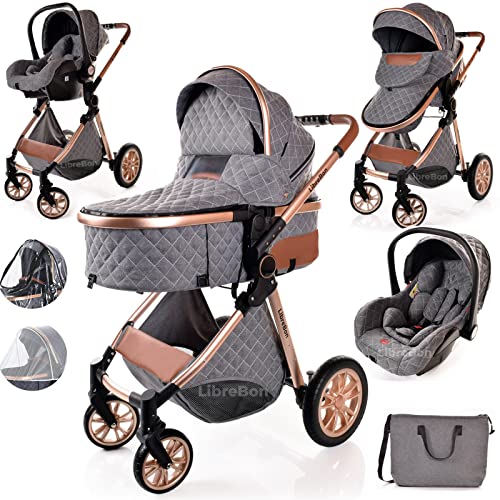Understanding Baby Prams and Pushchairs: A Comprehensive Guide
When it concerns caring for a newborn or a baby, few products are as essential as a reputable baby pram or pushchair. These movement aids supply a safe, comfortable method to transport babies while allowing moms and dads and caregivers the liberty to browse the world. This article checks out the numerous aspects of baby prams and pushchairs, assisting parents make informed choices about which product may be best matched for their family's needs.
What Are Baby Prams and Pushchairs?
Baby Prams: These are usually created for infants and very young babies. Foldable Double Pram have fully reclining seats that permit a flat position, making them suitable for newborns. Prams often feature a large, deep body, supplying additional defense and convenience.
Pushchairs: Pushchairs, also understood as strollers, are more flexible and can usually be changed for toddlers too. They are lightweight, easy to steer, and frequently feature a range of seating positions, consisting of reclined and upright.
| Feature | Baby Prams | Pushchairs |
|---|---|---|
| Ideal Age | Newborn to around 6 months | Newborn to 3 years or more |
| Seat Position | Fully reclined | Adjustable (reclined and upright) |
| Weight | Heavier, more robust | Lighter, more compact |
| Folding Mechanism | More complex folding | Generally easier folding |
| Maneuverability | Can be less maneuverable | Highly maneuverable |
Key Features to Consider
When choosing a baby pram or pushchair, potential buyers need to think about numerous crucial features that can affect the use and comfort for both the child and the caretaker.
1. Safety Features
- Five-point Harness: Ensures the baby is securely strapped in.
- Brakes: Reliable braking systems avoid mishaps.
- Stability: A broad base and well-constructed frame improve stability.
2. Comfort
- Cushioning: Ample padding on the seat ensures convenience.
- Suspension System: Provides a smoother ride on unequal surfaces.
- Canopy: A large, adjustable canopy secures the baby from sun and rain.
3. Portability
- Weight: Lighter designs are much easier to lift and carry.
- Folding Mechanism: Easy folding designs permit quick storage and transportation.
- Compact Size: A more compact size makes it simpler to suit cars and truck boots and tight areas.
4. Flexibility
- Convertible Options: Some models can be changed from a pram to a pushchair.
- Reversible Seat: Allows the baby to deal with the moms and dad or the world, depending upon preference.
- Accessories: Look for options that can accommodate vehicle seats or have a storage basket.
5. Sturdiness
- Product Quality: Invest in higher-end materials for durability.
- Weather Resistance: Water-resistant fabrics make sure that the pram/pushchair can endure different climate condition.
Types of Baby Prams and Pushchairs
Numerous types of baby prams and pushchairs meet various function requirements, lining up with moms and dads' specific way of lives.
1. Travel Systems
Travel systems typically integrate a safety seat and a stroller in one bundle, enabling seamless transportation from vehicle to pram or pushchair without disrupting the baby.
2. Umbrella Strollers
Umbrella strollers are light-weight and hassle-free, created for much easier maneuverability. They are perfect for quick trips and may lack some functions discovered in full-size strollers.
3. All-Terrain Pushchairs
These are best for active families who enjoy hiking or taking strolls on rugged terrains. They typically come with larger wheels for stability.
4. Jogging Strollers
Jogging strollers are created for moms and dads who want to combine workout with childcare. They feature strong frames and repaired front wheels to improve safety during a run.
The Importance of Choosing the Right Option
Choosing the proper baby pram or pushchair is not merely a matter of preference; it straight affects the security and comfort of the baby. Additionally, the right option can profoundly influence the lifestyle of the caretakers.
Advantages:
- Convenience: A well-chosen pram or pushchair makes getaways easier and more pleasurable.
- Health: Proper assistance helps in spinal and skeletal advancement in babies.
- Bonding: Outdoors play a vital function in parent-child bonding.
Frequently Asked Questions (FAQs)
1. At what age can my baby use a pushchair?
Many pushchairs are created to accommodate infants as young as six months, although some designs can be gotten used to securely transport newborns when used with compatible automobile seats.
2. How do I maintain my baby pram or pushchair?
Routine cleansing is important. Wipe down the frame and fabric with a damp cloth and mild soap. Regularly inspect the wheels and brakes for wear and tear.
3. Can I utilize a baby pram for jogging?
Normally, no. Regular baby prams lack the stability and style needed for jogging. Luxury Prams For Babies is much safer to use a stroller particularly designed for that purpose.
4. How do I pick the best size?
Consider how often you will be utilizing the pram/pushchair and where. If space is limited, look for a more compact style. For outside experiences, go with one with bigger wheels and excellent suspension.
Baby prams and pushchairs are invaluable tools for parents and caregivers, allowing safe and comfortable transport of infants and young children. By understanding the numerous features, types, and benefits included, caretakers can pick the very best movement aid matched to their needs. Whether it be a sophisticated travel system or a basic umbrella stroller, the ideal purchase can substantially enhance the experience of being a parent, making outings enjoyable and trouble-free for both moms and dads and babies alike.

